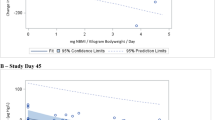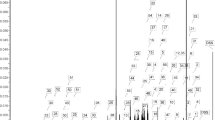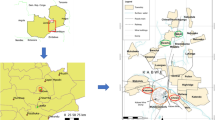Abstract
Methyl mercury cation (MeHg+) and divalent mercury (Hg2+) were quantified in urine, liver, kidney, and brain of prairie voles (Microtus ochrogaster) during a 12 week exposure to aqueous MeHg+ at concentrations of 10, 100, and 1000 ng MeHg+/mL. Aqueous MeHg+ exposures increased mercury accumulation in tissues of voles from each exposure group. Accumulation was greater within the higher two exposure groups. Similar [Hg2+] and [MeHg+] were determined within a given organ type before and after 2,3-dimercapto-1-propane sulfonate (DMPS) chelation. Similar correlations were seen for Hg2+ and MeHg+ concentrations in pre and post chelation urine. Post chelation urine more reliably predicted mercury species concentrations in tissues than did urine collected before chelation. These data demonstrate the utility of DMPS in noninvasive assessment of wildlife exposure to mercury, which may have utility in evaluating meta-population level exposure to hazardous wastes.
Similar content being viewed by others
Explore related subjects
Discover the latest articles, news and stories from top researchers in related subjects.Avoid common mistakes on your manuscript.
Mercury is a well documented toxicant, with the most severe risks arising from exposure to alkylated forms (Chumchal et al. 2011), particularly methylmercury cation (MeHg+). Understanding the time course of mercury distributions among tissues at environmentally realistic exposures is important to determine the risk that wildlife experience from MeHg+ exposure. While controlled chronic mercury exposure studies have determined toxicokinetic and teratogenic effects that relate to human health (Curtis et al. 2010; Lewandowski et al. 2002; Woods et al. 1991), few studies have provided measured concentrations of mercury in tissues together with consequential health affect endpoints for the protection of wildlife species. These data gaps have precluded prediction of risk to mercury-exposed wildlife (Meyer 1998).
Well-established non-lethal methods of assessing metal exposure include blood, urine, or hair analyses (Beyer et al. 1996; Cobb et al. 2007; Rainwater et al. 2009). However, these methods do not measure toxic metal concentrations in target organs. Safe and effective chelation can be achieved with 2,3-dimercapto-1-propane sulfonate (DMPS). Administration of DMPS, subsequent collection of urine, and analysis of depurated metals can improve estimates of toxic metal concentrations in tissues of mammalian species (Cherian et al. 1988; Aposhian 1998; Maiorino et al. 1996; Pingree et al. 2001a, b). An accurate non-lethal method for assessing environmentally relevant exposure in mammals exposed to metals would offer many benefits. Without the need to kill the subjects collected, many animals can be assessed repeatedly. Increasing the sample size and statistical power of analysis would increase certainty of relationships between contaminant exposure and effect endpoints.
Small mammals provide good estimates of metal contamination and toxic effects in the environment (Talmage and Walton 1991; Wren 1986). Voles, Microtus ochrogastor, are widespread (Beardsley et al. 1978), omnivorous, and semi-fossorial. As such, they are readily exposed to environmental contaminants and are easily captured (Talmage and Walton 1991). The primary objective of this study was to develop a non-lethal technique for assessing mercury exposure in a small mammal species. To accomplish this, we characterized the relationship between mercury concentrations in urine and those in tissues of prairie voles exposed to MeHg+ during a study design that evaluated temporal and dose dependence of uptake and excretion. Exposure concentrations were chosen to bracket known mercury exposures in contaminated areas. Although typical mercury concentrations in freshwaters normally do not exceed 0.09 ng/mL (Leopold et al. 2010), concentrations in surface water from mining areas in Spain ranged from <0.1 to 23 ng/mL (Ordonez et al. 2013). In geologically active areas of Pakistan and mining regions of the USA, surface water concentrations reach 0.14–0.15 ng/mL (Gray et al. 2015), while leachate from mine wastes in China contained 2–3 ng/mL of mercury (Biber et al. 2015).
Materials and Methods
Procedures for vole care, handling, and dosing are presented elsewhere (Cobb et al. 2007; Rummel 2000). Drinking water was fortified with aqueous MeHgOH (Sigma Chemical Co., St. Louis, MO, USA) at nominal concentrations of 10, 100, and 1000 ng/mL. Analytical verification of each test solution indicated the presence of 9, 103, or 920 ng MeHg+/mL in the respective test solutions. These solutions represented the sole source of water (Cobb et al. 2007; Rummel 2000). Voles were randomly assigned to control and treatment groups and placed in metabolism cages. Urine was collected from control voles for 24 h at week 0. Urine was collected by removing the liquid from the liquid trap, below the metabolism cage. Ten control voles received an intraperitoneal (IP) injection of 1.0 mmol/kg DMPS. Urine was collected from both groups for 24 h. Controls were euthanized with CO2 and dissected to remove tissues, which were frozen in liquid nitrogen. The remaining voles were distributed into four exposure groups that received MeHg+ for 3, 6, or 12 weeks. After each interval, 10 voles from each group received IP DMPS. Urine was collected for 24 h after injection with DMPS, and voles were euthanized as described above.
Chemical analyses followed the method of Cobb et al. (2007). Briefly, samples were lyophilized in 10 M KOH at 95°C and after cooling were acidified to a pH of 2. Acidified digests were filtered (1 µm Teflon filters: Sigma-Aldrich) and volumetrically diluted. Mercury speciation used borohydride ion to liberate mercury species from extracts and stannous ion to selectively reduce mercuric ion into a flow injection cold vapor atomic absorption spectophotometer (FIMS-400, Perkin Elmer). This method demonstrated recoveries of 80.1 ± 5.0 for Hg2+ and 95.1 % ± 1.3 % for MeHg+ in urine; 73.1 ± 7.4 for Hg2+ and 75.0 ± 7.7 for MeHg+ in kidney; and 63.5 ± 12.5 for Hg2+ and 100.6 ± 7.0 for MeHg+ in brain tissue.
All data were log transformed before statistical treatment. ANOVA with Bonferonni correction was performed to evaluate differences (p ≤ 0.05) between mercury concentrations in each exposure group, tissue type, and DMPS treatment. Three way ANOVAs were performed to determine overall variance across all exposure groups, tissue types, and DMPS treatments. This was followed by a series of two way ANOVAs and one way ANOVAs.
Simple regressions of two types were performed using MiniTab©. First, mercury concentrations in each tissue type were treated as independent variables and mercury concentrations in urine as the dependent variable. Secondly, mercury in non-chelated tissue was treated as the independent variable and mercury concentration in DMPS-chelated tissue was treated as the dependent variable.
Results and Discussion
[MeHg+] in kidney and urine were similar in concentration, followed by liver then brain (Fig. 1). Urine had the highest [Hg2+], followed by kidney, brain, and liver. When considering all exposure groups as compared to control, significant increases (p < 0.0001) were observed in both [MeHg+] and [Hg2+]. This finding justified further investigation of differences within and among these treatment groups. These more in depth comparisons showed [MeHg+] and [Hg2+] plateaued after week three in lower exposure groups (Table 1) but increased temporally in groups receiving higher exposures. This pattern held true for Hg2+, but not MeHg+, in urine. It should also be noted that exposure intervals shorter than 12 weeks were less likely to increase [Hg2+] (Table 2) . [MeHg+] in tissues of control and low exposure voles were similar at all time points (Table 2, footnote). [MeHg+] and [Hg2+] in tissues also demonstrated interaction between exposure concentration and tissue type (p < 0.036).
These findings confirm work with voles that did not receive DMPS (Cobb et al. 2007), wherein [Hg2+] or [MeHg+] increased with exposure, and concentrations stabilized in tissues by week three (Cobb et al. 2007). In the absence of chelation, exposure concentration and duration increased [Hg2+] or [MeHg+] in tissues (p < 0.001). Kidney contained the highest [MeHg+] followed by urine, brain, and liver. [MeHg+] increased in urine of the low exposure cohort, until week six (Cobb et al. 2007).
As compared to data from our previous work, chelation did not generally alter [Hg2+] or [MeHg+] from 10 and 100 ng/mL exposure groups. In the few cases where DMPS caused differences, concentrations decreased in tissues following treatment. Thus, DMPS treatment increased Hg2+ or MeHg+ urinary excretion from higher exposure groups at weeks six and 12. Mercury concentrations in vole kidney and brain from higher exposures support the idea that Hg2+ and MeHg+ are removed from tissues and excreted in urine. Post-chelation mercury was lower in the brain than non-chelated mercury for the 10 µg/L exposure at week six.
Regressions of mercury concentrations in DMPS urine and organ tissues suggested that post-DMPS urine provided a better estimation of mercury species in organ tissues than did untreated urine. For voles receiving saline in our previously published work, highly significant and moderately powerful regressions (0.32 < r2 < 0.40, p < 0.001) were found for [MeHg+] in urine versus renal, hepatic, or brain tissue (Table 3). Less powerful regressions were obtained for Hg2+ in urine versus tissue (0.31 < r2 < 0.341, p < 0.001).
Significant regressions were obtained (p < 0.0001) for both [Hg2+] and [MeHg+], when tissues of voles that received DMPS chelation were compared to non-DMPS treatments. Correlations were high for [MeHg+] (r2 > 0.957) and [Hg2+] (r2 > 0.909) in hepatic tissues (Table 4). Comparisons of mercury concentration in urine before and after chelation could be made on an individual basis. [Hg2+] in urine with and without chelation showed a significant regression (y = 0.927x + 0.300, p < 0.0001); however, the correlation (r2 = 0.535) was lower than for regressions using average [Hg2+] in urine. The [MeHg+] in urine responded similarly with a significant regression (y = 0.971x + 0.411, p < 0.0001) and a lower correlation (r2 = 0.501). When data were pooled by treatment group, post-DMPS chelated urine versus post saline treatment urine data demonstrated strong correlation, and significant regression (p < 0.0001) for MeHg+ and Hg2+ (y = 1.1602x − 0.112, r2 = 0.8954; and y = 1.112x − 0.0638, r2 = 0.9133, respectively).
Regressions of mercury in tissues from DMPS treated voles versus saline treated voles produced slopes that ranged from 0.867 to 1.02 demonstrating the consistency of mercury species in tissues before and after chelation treatment. For each tissue evaluated, mercury in urine as a function of mercury in tissue (Cobb et al. 2007) produced highly significant regressions (p < 0.001). Stronger regressions for mercury concentrations were obtained when DMPS chelation was employed (0.486 < r2 < 0.677) as compared to regressions using data from non-chelated cohort (0.318 < r2 < 0.399).
Chronic exposure of a representative wildlife species to low mercury concentrations (<1 μg/mL) in drinking water allowed the development of a framework for estimating mercury accumulation in tissues by quantifying mercury excretion in urine. Throughout the study, [Hg2+] and [MeHg+] were higher in tissues of exposed voles. The predominant form of mercury found in the liver and brain was MeHg+. In the highest exposure group, DMPS decreased mean total mercury concentrations in liver and kidney, but not in brain. This was observed with a complementary four to fivefold increase in total urinary mercury excretion. Differences between post DMPS total mercury concentrations and non-DMPS total mercury concentrations in soft tissues represented approximately half of the difference observed in urine. This suggests mercury removal from other reservoirs in the body. In our study, DMPS most effectively decreased total body burden of mercury in voles exposed to either 1.0 or 0.1 ng/mL MeHg+.
MeHg+ and Hg2+ were found in almost equal portions in both kidney and urine. The predominant form of mercury found in the liver and brain was MeHg+. These results were expected since ingested MeHg+ is more likely to reach the brain or liver before encountering the kidney. A 1:1 ratio of renal MeHg+ and Hg2+ mercury can be explained by metabolism in organs before mercury reached the kidney and by urinary clearance through the kidney. The time required to reach the 1:1 ratio occurred sooner and at far lower concentrations than previously reported. Rats exposed to either 5 or 10-ppm MeHg+ in drinking water did not produce this 1:1 ratio until renal mercury concentrations were 60 µg/mL (Woods et al. 1991). Our study used a maximum exposure of 1 µg/mL MeHg+ and achieved a 1:1 ratio before mercury in renal tissues reached 1 µg/g. This suggests demethylation and/or excretion of MeHg+ proceeds even when exposures occur at low concentration.
Neurological damage and dysfunction caused by low [MeHg+] in brain tissue (Mergler et al. 1998), posed concerns regarding whether DMPS redistributes MeHg+ to the brain. Our study showed no increase in [MeHg+] or [Hg2+] within the brain. Also, a slight but insignificant decrease in total mercury concentration was seen in brain tissue.
Urinalysis after chelation has been an effective non-invasive technique for estimating body burdens of a metal (Gonzalez-Ramirez et al. 1995; Kosnett 2010). Previously, we demonstrated that without chelation, strong relationships existed between urinary and organ derived mercury concentrations (Cobb et al. 2007). Our current work demonstrates stronger relationships (p < 0.001) for mercury species in tissues and urine following DMPS chelation, thus establishing a bridge from mercury concentrations in non-chelated tissues and post chelation urine. The relationship between the post-chelated urine and tissues is the key to non-lethal and non-invasive estimates of mercury concentrations in soft tissues. These relationships provide a powerful basis for models to estimate mercury concentrations in target tissues and could allow multiple assessments of rodents during long term exposure scenarios, including field studies. This technique could be used with larger wildlife species to better identify hazardous sites. Studies could include mercury accumulation or bioconcentration in predators of small mammals, such as mink, otters, or Florida panthers.
References
Aposhian HV (1998) Mobilization of mercury and arsenic in humans by sodium 2,3-dimercapto-1-propane sulfonate (DMPS). Environ Health Persp 106:1017–1025
Beardsley A, Vagg MJ, Beckett PHT, Sansom BF (1978) Use of field vole (M-agrestis) for monitoring potentially harmful elements in environment. Environ Poll 16:65–71
Beyer W, Heinz GH, Redmon-Norwood AW (1996) Environmental contaminants in wildlife: interpreting tissue concentrations. Lewis Publishers, Boca Raton
Biber K, Kahn SD, Shah MT (2015) The source and fate of sediment and mercury in Hunza River basin, Northern Areas, Pakistan. Hydrol Process 29(4):579–587
Cherian MG, Miles EF, Clarkson TW, Cox C (1988) Estimation of mercury burdens in rats by chelation with dimercaptopropane sulfonate. J Pharmacol Exp Ther 245(2):479–484
Chumchal MM, Rainwater TR, Osborn SC et al (2011) Mercury speciation and biomagnification in the food web of Caddo Lake, Texas and Louisiana, USA, a subtropical freshwater ecosystem. Environ Toxicol Chem 30(5):1153–1162
Cobb GP, Moore AW, Rummel KT, Adair BM, McMurry ST, Hooper MJ (2007) Mercury and methylmercury accumulation and excretion in prairie voles (Microtus ochrogaster) receiving chronic doses of methylmercury. Arch Environ Contam Toxicol 52(3):441–449
Curtis JT, Hood AN, Chen Y, Cobb GP, Wallace DR (2010) Chronic metals ingestion by prairie voles produces sex-specific deficits in social behavior: an animal model of autism. Behav Brain Res 213(1):42–49
Gonzalez-Ramirez D, Maiorino RM, Zunigacharles M et al (1995) Sodium 2,3-dimercaptopropane-1-sulfonate challenge test for mercury in humans.2. Urinary mercury, porphyrins and neurobehavioral changes of dental workers in Monterrey, Mexico. J Pharmacol Exp Ther 272(1):264–274
Gray JE, Theodorakos PM, Fey DL, Krabbenhoft DP (2015) Mercury concentrations and distribution in soil, water, mine waste leachates, and air in and around mercury mines in the Big Bend region, Texas, USA. Environ Geochem Health 37(1):35–48
Kosnett MJ (2010) Chelation for heavy metals (arsenic, lead, and mercury): protective or perilous? Clin Pharmacol Ther 88(3):412–415
Leopold K, Foulkes M, Worsfold P (2010) Methods for the determination and speciation of mercury in natural waters—a review. Anal Chim Acta 663(2):127–138
Lewandowski TA, Pierce CH, Pingree SD, Hong S, Faustman EM (2002) Methylmercury distribution in the pregnant rat and embryo during early midbrain organogenesis. Teratology 66(5):235–241
Maiorino RM, GonzalezRamirez D, ZunigaCharles M et al (1996) Sodium 2,3-dimercaptopropane-1-sulfonate challenge test for mercury in humans. 3. Urinary mercury after exposure to mercurous chloride. J Pharmacol Exp Ther 277(2):938–944
Mergler D, Belanger S, Larribe F et al (1998) Preliminary evidence of neurotoxicity associated with eating fish from the upper st. Lawrence River lakes. Neurotoxicology 19(4–5):691–702
Meyer MW (1998) Ecological risk of mercury in the environment: the inadequacy of “the best available science”. Environ Toxicol Chem 17(2):137–138
Ordonez A, Alvarez R, Loredo J (2013) Asturian mercury mining district (Spain) and the environment: a review. Environ Sci Pollut Res 20(11):7490–7508. doi:10.1007/s11356-013-1663-4
Pingree SD, Simmonds PL, Rummel KT, Woods JS (2001a) Quantitative evaluation of urinary porphyrins as a measure of kidney mercury content and mercury body burden during prolonged methylmercury exposure in rats. Toxicol Sci 61(2):234–240
Pingree SD, Simmonds PL, Woods JS (2001b) Effects of 2,3-dimercapto-1-propanesulfonic acid (DMPS) on tissue and urine mercury levels following prolonged methylmercury exposure in rats. Toxicol Sci 61(2):224–233
Rainwater TR, Sauther ML, Rainwater KAE et al (2009) Assessment of organochlorine pesticides and metals in ring-tailed lemurs (Lemur catta) at Beza Mahafaly Special Reserve, Madagascar. Am J Primatol 71(12):998–1010
Rummel K (2000) Porphyrin profile and chelator techniques in the assessment of mercury expose and effects. Ph.D. Dissertation. Texas Tech University
Talmage SS, Walton BT (1991) Small mammals as monitors of environmental contaminants. Rev Environ Contam Toxicol 119:47–108
Woods JS, Bowers MA, Davis HA (1991) Urinary porphyrin profiles as biomarkers of trace-metal exposure and toxicity—studies on urinary porphyrin excretion patterns in rats during prolonged exposure to methyl mercury. Toxicol Appl Pharmacol 110(3):464–476
Wren CD (1986) Mammals as biological monitors of environmental metal levels. Environ Monit Assess 6(2):127–144
Acknowledgments
This research was funded by the NIEHS Superfund Basic Research Program (ES04696).
Author information
Authors and Affiliations
Corresponding author
Rights and permissions
About this article
Cite this article
Cobb, G.P., Moore, A.W., Rummel, K.T. et al. Dimercaptopropane Sulfonate Chelation Affects In Vivo Hg and MeHg Distribution in Tissues and Urine of Prairie Voles (Microtus ochrogaster). Bull Environ Contam Toxicol 95, 707–713 (2015). https://doi.org/10.1007/s00128-015-1651-0
Received:
Accepted:
Published:
Issue Date:
DOI: https://doi.org/10.1007/s00128-015-1651-0





